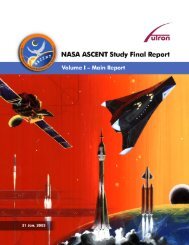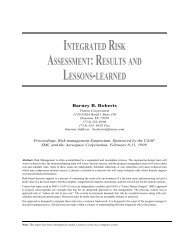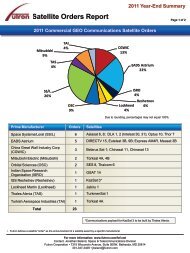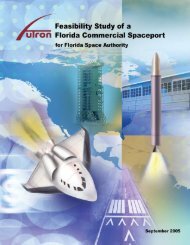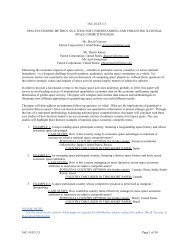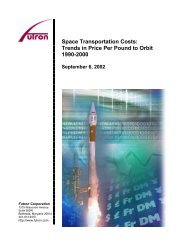Mobile Satellite Services - Futron Corporation
Mobile Satellite Services - Futron Corporation
Mobile Satellite Services - Futron Corporation
You also want an ePaper? Increase the reach of your titles
YUMPU automatically turns print PDFs into web optimized ePapers that Google loves.
<strong>Mobile</strong> <strong>Satellite</strong> <strong>Services</strong>: Status Check for First RespondersMOBILE SATELLITE SERVICES:STATUS CHECK FOR FIRST RESPONDERSFollowing the 2005 hurricane season, with its devastating storms, businesses and governmental agenciesaround the United States recognized the benefits provided by <strong>Mobile</strong> <strong>Satellite</strong> <strong>Services</strong> (MSS) with theirfrom-anywhere-to-anywhere availability and consumer-friendly terminals.These terminals and services are largely immune to the effects of the devastating damage totelecommunications infrastructure seen in the wake of Hurricane Katrina.2008 is another challenging year, with first responders around the United States already dealing with thebeginnings of a busy and difficult season of managing natural disasters. From wildfires in the west tofloods in the mid-west, the season has started dramatically, and the National Hurricane Center has justforecast a bad season ahead with 9 major hurricanes predicted. With this in mind, we have reviewed thecurrent status of the existing MSS systems to provide some insight into what users can expect, and whatpreparations they need to make to ensure they are able to get the communications capabilities they need tomeet these challenges.While the range of services required to support recovery and reconstruction activities following naturaldisasters are supported by multiple satellite communications systems, handheld satellite services, whichtoday are available in North America only from LEO satellite systems, have proven themselves to beindispensable during the search and rescue phase of activities which occurs immediately following eachdisaster.For emergency services users there is a need to take steps now to best ensure that they can rely on thesystems they currently use, including the systems capable of providing handheld satellite communicationsservice. The following chart provides an overview of these alternatives, and the rest of this paperdiscusses each system in more detail.Handheld Service -Highly Portable/Low CostVoice ServiceData ServiceNearterm SystemContinuityIndependence fromTerrestrialInteroperabiityGlobal CoverageNearterm SystemFundingNext Generation SystemDefinitionEstablished Distribution& Support SystemAsset TrackingOptimizedGlobalstar • • ◦ • • •Iridium • • • • • • • • • •MSV • • ◦ • Inmarsat ◦ • • • • • • • Key: • = optimal; = partial; ◦ = limited or not available© <strong>Futron</strong> <strong>Corporation</strong> 20081<strong>Futron</strong> <strong>Corporation</strong>
<strong>Mobile</strong> <strong>Satellite</strong> <strong>Services</strong>: Status Check for First RespondersWHAT ARE THE PROMISES?It has been ten years since the mobile satellite industry expanded dramatically beyond its traditional corewith the launch of service on a series of LEO systems which, as noted above, for the first time madehandheld satellite service available. With their lightweight and handheld satellite phones, LEO systemssuch as Iridium and Globalstar represented a breakthrough for the satellite services industry. <strong>Satellite</strong>communications gained dimensions of mobility and portability previously unimaginable.There are now four MSS operators, only two of which are LEO systems with handheld service, currentlyproviding voice and data service to North America, with at least one new operator planning to introduceservice by 2010. But for the emergency communications users the basic questions are: what can I getnow, and what will I get next year or the year after?To answer those questions, the following table depicts the basic services offered and currently availablefrom each of the providers, as well as a snapshot of their planned next generation expansion capabilities.System Service Types<strong>Services</strong> Currently Availablein North AmericaGlobalstar Voice, Data Voice service limited due tosatellite anomalies; sporadicalthough predictable outagesData services fully availableTerminal Types inNorth AmericaHandheldNext Generation <strong>Services</strong>PlannedUp to 256 kbps from the handset;up to 1 Mbps downlink to usersIridium Voice, Data Voice and data services fullyavailableMSV Voice, Data Voice and data service fullyavailableHandheld<strong>Mobile</strong>, handportableUp to 64 kbps for handheld; up to128 kbps for mobile broadband;up to 1 Mbps for mobile highspeed serviceVoice, data, multimedia integratedwith terrestrial via ATCInmarsatVoice, high-speeddataVoice and data services fullyavailable<strong>Mobile</strong>, portableCircuit-switched up to 64kbpsISDN; packet-switched up to 492kbpsWHAT ARE THE CHALLENGES?As indicated above, all of these systems are at some stage in the process of building next generationsatellites - Inmarsat has almost completed the deployment of its I-4 series, Globalstar, and MSV havesatellites under construction, and Iridium is getting ready to let a contract for its second generation.While the expanded capabilities shown above are attractive, looking a bit more deeply at the plannedenhancements of each operator, it is clear that, before those capabilities are deployed significantchallenges will need to be overcome. These challenges include a range of technical, market, financingand regulatory issues.For some systems the next 2-3 years will be critical as they must successfully finance, launch and deploynew constellations of satellites to maintain or commence service. All of the companies are taking steps to© <strong>Futron</strong> <strong>Corporation</strong> 20082<strong>Futron</strong> <strong>Corporation</strong>
<strong>Mobile</strong> <strong>Satellite</strong> <strong>Services</strong>: Status Check for First Respondersdevelop partnerships across these areas. Financial partnerships include both individual companyprograms conducted by Globalstar and Iridium as well as cross-company investments by private equityfirms such as Harbinger Capital, who are invested in Inmarsat, MSV and TerreStar.There are significant financial challenges to be met by many of these companies to build or sustainbusiness over the next five years. Exceptions are Inmarsat, which has a solid, long-established financialposition, and to a somewhat lesser degree Iridium, which has both a significant anchor tenant in the USGovernment and a consistently growing revenue base on satellites that do not need near-termreplacement. All of the others need to finance, construct and launch new satellites within the next 2-3years while sustaining and growing business on increasingly limited satellite assets.On the distribution side partnerships are evolving to better serve customers and ensure access toequipment as well as services as and when needed. Finally, on the regulatory front, all companies areworking continuously with the FCC to have a regulatory landscape which provides a positive futureenvironment for the user.Within this general framework, however, each system has its own challenges, some more immediate thanothers, as summarized in the following table, and discussed in more detail below.System Technology Partnerships and Financing RegulatoryGlobalstar Constellation needs immediate replacement ATC/terrestrial partner needed. ATC licenses now in place from- 40 launches planned starting 2009.Associated ATC design and deploymentuncertainFinancing still needed to supportcurrent satellite construction andensure service beyond 2009FCC for full spectrumIridiumCurrent 66 satellite system appears fineuntil 2013. NEXT generation technologiesstill in definition with risks of constructionand launch.New financing currently in process,along with pursuit of government andother "rideshare" partners to supportNEXT plansNo specific issues at presentMSVCurrently one GEO satellite. Newtechnologies on two satelllites planned forlaunch 2009/2010 comlemented by ATC.ATC design and deployment uncertain.ATC/terrestrial partner needed.Financing still needed to supportcurrent satellite construction andensure future service continuity.Spectrum-sharing agreementwith Inmarsat facilitates growthInmarsat 10 GEO satellites now on orbit. Last I-4launch delayed because of Proton failureSolid ongoing revenues and investors.ACeS partnership for dual-modeand remains a risk. New dual-mode satellite phones. AlphaSat program forand GSM phone launched mid-2007 in theMiddle East, Africa and Asia.advanced services in developmentwith European Space Agency (ESA).TerreStarNew technologies on two satelllites plannedfor launch 2009/2010 - orignial dates2007/8. ATC design and deploymentuncertain.Financing still needed to support initialsatellite construction. Managementand staff turnover apparently tied tofunding.Spectrum-sharing agreementwith MSV facilitates growthRecent spectrum expansion viaagreements with EchoStar,CCTV Wireless and HarbingerCapitalGlobalstar, one of only two companies providing handheld service in North America, is experiencingsatellite anomalies which present perhaps the most visible and immediate risks, and the company hasconfirmed in filings with the FCC that there are times of the day when its coverage for voice services fallsshort of the level expected under the Commission’s rules. 1 What this means is that phone service on theGlobalstar system is not always available. In reporting on this situation in November 2007, industrypublication <strong>Satellite</strong> Finance stated that: "While its low cost simplex products for asset tracking hascontinued to attract demand, subscriber numbers for its two-way voice and data services have flattenedsince the degradation of services began and much of the company's plans are reliant on its next generation1 Globalstar filing with the FCC January 4, 2008 FCC File No. SAT-STA-20070713-0098© <strong>Futron</strong> <strong>Corporation</strong> 20083<strong>Futron</strong> <strong>Corporation</strong>
<strong>Mobile</strong> <strong>Satellite</strong> <strong>Services</strong>: Status Check for First RespondersInternet blogs, while all systems receive some critical or skeptical commentary, the highest level ofconcerns expressed for the near-term MSS business has involved Globalstar.As noted above, the company has been open in its regulatory filings about the degree to which its currentspacecraft anomalies have limited service availability, in particular limited voice service. Beyond this thepublic commentary has been extensive. Notes by satellite industry trade publication <strong>Satellite</strong> Today fromthe recent NAB conference even started with the inflammatory headline “Is Globalstar Rearranging TheDeck Chairs?” 3 and continued to discuss concerns among conference attendees with the company’sability to sustain voice service availability through the next 12-18 months pending launch of the newconstellation.There have not been any similar concerns expressed with the ability of the other operational systems -Inmarsat, Iridium, and MSV - to provide service this hurricane/wildfire season or next. Questions docontinue to be raised for the longer term about the ability of the latter two to finance and launch capacityneeded by 2012-2014.WHAT ARE THE NEXT STEPS?For organizations gearing up to face the challenges of disaster response and emergency communications,the good news is that MSS systems offer a wide range of solid choices for both voice and data servicesthis year. That being said, the options are reduced from last year, and many of the promised newcapabilities are on hold, awaiting satellites, partners and money.First responders and others with a genuine potential need for such services thus need to carefully assesswhether the specific equipment they own and the associated services will be available when needed.Candid, early discussions with service providers are the best way to determine whether the solutionsprocured over the past 2-3 years will be the best options for the next 2-3 years. Emergency managersneed to review the equipment they have on hand as well as the service agreements associated with thatequipment, and contact their service providers to verify the current system status. All of the MSS systemoperators reviewed in this paper are ready and willing to have those discussions, to ensure that firstresponders are effectively equipped to communicate as and when needed.3 <strong>Satellite</strong> Today Blog Posted: April 17, 2007 by Jason Bates Filed under: NAB 2007 Permalink© <strong>Futron</strong> <strong>Corporation</strong> 20085<strong>Futron</strong> <strong>Corporation</strong>




